Japanese Maneki Neko, also known as the lucky cat or beckoning cat, is believed to bring good luck and is closely related to the Japanese culture, history, and art. It is seen everywhere as you travel in Japan, and is found around the world as a decoration at home or in businesses.
A special charm of Japan is that the cute little Maneki Neko statues come with raised left or right paws, different colors, and different items inside, representing various auspicious meanings, i.e., fortune and prosperity.
Before you take the lucky cat Maneki Neko as a gift idea, let’s start our journey exploring these iconic Japanese figurines with their meanings, origins, and fascinating customs.
Table of Contents
What is a Maneki Neko?
The Maneki Neko's Paw and Meanings
The Meanings Behind the Items a Maneki Neko Holds
Maneki Neko Cat Color Meanings
Where to Place Your Maneki-Neko
What is the Origin of Maneki Neko?
Maneki Neko in Popular Culture
Make a Maneki Neko Yourself at Cafe Nekoemon
More Maneki Neko Gift Ideas: Necklace, Plush...
Where to Buy Maneki Neko on Your Japan Trip
Maneki-neko Around the World
What is a Maneki Neko?
Often made of ceramic or cloth and styled as a cat with one paw raised in a beckoning gesture, the Maneki Neko is seen as a symbol of attracting wealth and bringing good fortune. Traditionally, it is seated and holds a koban coin. A bell is tied around the lucky cat's neck to symbolise the sound of the coin being heard. On its chest may be the words “gold”, “treasure”, or a logo representing a merchant. There are also colourful patterns on the Maneki Neko cat sculpture: cherry blossom (meaning good luck), wave pattern (meaning repelling disasters), etc. The lucky cat Maneki Neko may also be decorated with a flower pattern.
They are often placed in shops, cash registers, or offices to attract customers and improve their fortune. In Japan, many old shops still keep this tradition.
How do You Pronounce Maneki Neko?
Maneki Neko is 招き猫 in Japanese and まねき ねこ in hiragana. It is pronounced as "Mah-neh-kee Neh-koh". "Maneki" means "beckoning" (招き), and "neko" (猫) is "cat" -- so it’s literally "beckoning cat."
How Big is a Maneki Neko Cat?
Japanese Maneki Neko comes in a variety of sizes, the exact size usually depends on the purpose and the scene of placement, ranging from miniature ornaments to large decorations.
Small Maneki Neko cats are between 5cm and 15cm in height, usually made of ceramic, resin, or plastic, and are used for cash registers, desks, and shelves.
Medium-sized lucky cats are 20cm to 50cm in height, usually made of ceramics and enamels, and are used at shop counters, doorways, or shrines.
Large-sized lucky Maneki Neko cats are 60cm to 1.5m in height or even larger, usually made of fibreglass, metal, or concrete, and are used in restaurants, shopping malls, temples, and other public places.
The super-mini figurines are around 3cm and are mainly used for mobile phone pendants and jewellery.
Electric Maneki Neko (the style with beckoning paws) are usually small to medium-sized.
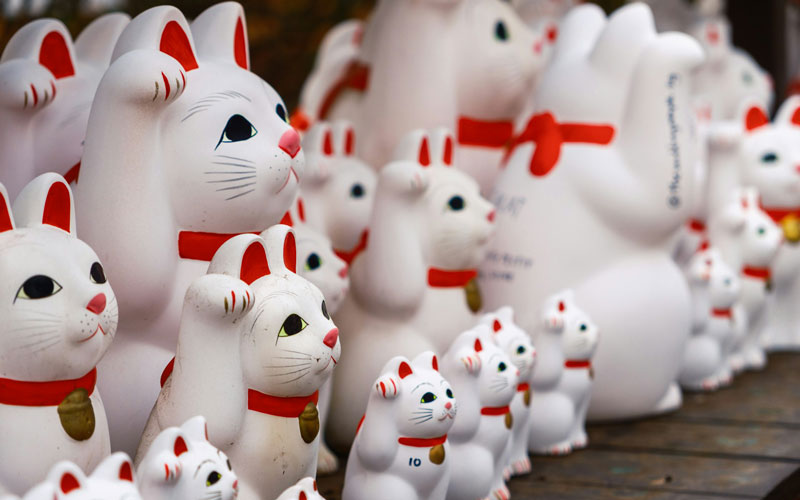
The Maneki Neko's Paw and Meanings
The different postures of the lucky cat, i.e., holding up different paws, are an important reflection of its cultural connotation and convey different blessings.
Right Paw Raised
Legend has it that the white cat points its right paw in the direction of the source of wealth. Therefore, the right paw is raised to symbolise “attracting wealth”.
Where to place it: home, shop, office
Left Paw Raised
In the Edo period, merchants believed that the left paw represented welcoming guests. As most people held things in their right hand, such as a money bag, the left hand was left free to welcome guests.
Where to place it: shop checkout counters, entrances, or catering and service establishments.
Both Paws Raised
Some of the Maneki Neko cats hold up bells or Koban coins with both hands to attract wealth and customers at the same time.
Where to place it: business, family, or as a high-end gift.
One Paw Waving
One paw is open, as if spreading money or sending blessings, dispelling bad luck.
Where to place it: entrance, courtyard, used to dissolve bad luck or improve the overall luck.
In the Kanto region (Tokyo area) of Japan, most of the Maneki Neko are right-handed due to traditional beliefs. In the Kansai region (Osaka, etc.), some of the Maneki Neko are left-handed, as the region was once dominated by commerce.
Traditionally, the one holding up the right hand is mostly a female cat (symbolising good fortune), and the one holding up the left hand is a male cat (symbolising wealth). However, there is no strict distinction nowadays.
The Meanings Behind the Items a Maneki Neko Holds
Koban Coin
A direct symbol of wealth, representing wealth and prosperity. Koban coins are often engraved with the characters for “gold” or “treasure”, or are designed in the style of “koban” (oval gold coins) from the Edo period.
Bells
The sound of the bell is a symbol of the sound of money, which attracts wealth and good fortune. The motion of shaking the bell symbolises the dispelling of bad luck and attracting wealth. Some of the bells are tied with a red cord to represent “bonding” and “guardianship”.
Fukubukuro
Fukubukuro represents good fortune and luck, and is derived from the Japanese custom of drawing lots for the New Year. A golden knot is tied at the mouth of the bag to symbolise the sealing of good fortune.
Senryō-bako
A traditional symbol of wealth in Japan, originating from the wooden boxes used by daimyo to transport money during the Edo period. It symbolises the accumulation of wealth over a long period of time and the ability to keep wealth.
Koinobori
The carp swims upstream against the current, symbolising success against all odds. It is culturally associated with the summer “Boys’ Day” (Dragon Boat Festival) and symbolises vitality and growth.
Maneki Neko Cat Color Meanings
White Maneki Neko
White represents purity and sanctity in Japanese culture and is the most classic colour of the Maneki Neko. White Maneki Neko is suitable for any prayer scene.
Black Maneki Neko
Black Maneki Neko can ward off evil spirits and protect the home. According to some legends, Black Maneki Neko can turn calamities into blessings.
Golden Maneki Neko
Gold is directly associated with gold and wealth. Moreover, in Japanese Shintoism, gold is considered the “colour of the sun” and represents the blessing of the gods.
Red Maneki Neko
In Japanese tradition, red charms are used to suppress evil spirits, and Red Maneki Neko statues can ward off illness and bring good luck.
Where to Place Your Maneki-Neko
The position and orientation in which the Maneki Neko statue is placed will directly affect its symbolic effects of attracting wealth and guests, and warding off evil spirits. Below are some suggestions on how to place the cat, taking into account its colour, posture, and the item it holds.
Best Places
For shops and commercial establishments, it is recommended to be placed on the left side of the cash register or counter. A Maneki-Neko cat with its left paw raised should face the doorway, while a Maneki-Neko cat with its right paw raised can be placed next to the cash register.
For homes, it is recommended to place it in the living room on a high display cabinet with the cat's face facing the doorway.
For offices, it is recommended to place it in the upper left corner of the desk.
Traditionally, it is believed that the left paw raised is suitable for shops and the right paw raised is suitable for homes.
Height
The optimum height is 30 to 60cm above the ground. If placed at the cashier's desk, it is recommended to be at eye level with the owner to symbolise that the cat and the owner are of one mind.
Places to Avoid
Avoid inverted Maneki-Neko or broken Maneki-Neko.
Avoid toilets, as dirt and filth may interfere with good fortune.
What is the Origin of Maneki Neko?
There are various theories as to the origin of the lucky cat Maneki Neko. One theory is that it is related to the ancient Chinese “fortune cat” or “golden cat”. It was introduced to Japan and became popular during the Edo period (17th-19th centuries).
The “paw-raising” motion of the Japanese Maneki Neko is derived from the gesture of a cat washing its face. In the Tang Dynasty, Duan Chengshi wrote in his “Youyang Miscellany Chopper” that “when a cat washes its face and crosses its ears, a guest arrives”. In Qishan, Shaanxi, there is a statue of a “fortune cat” that was found in a group of caves from the Northern and Southern Dynasties more than 1,600 years ago.
Gotokuji Temple in Tokyo - the Lucky Maneki Neko Temple
At the beginning of the Edo period, a poor wandering monk fell ill while wandering. A snow-white cat appeared and guided him to a dilapidated temple (the predecessor of Hotokuji). The monk stayed there while the white cat guarded the temple entrance day and night. One day, a noble woman passed by the temple and was attracted by the spirit of the white cat and stopped to worship it. She then donated a large amount of money, and the temple was renovated and expanded. The temple flourished because of the white cat's ability to attract visitors, and the monks enshrined the cat as a “lucky cat”.
In real history, the revival of the temple was linked to Lady Awan, the concubine of Tokugawa Iemitsu, the third shogun of the Tokugawa Shogunate. She donated a large amount of money to rebuild the temple as she prayed for the success of her wish for a son.
Today, a large number of lucky Maneki Neko cats are still enshrined in the Hotokuji Temple, and visitors can purchase different coloured cats as amulets. The temple has a special Maneki Neko Cat Hall where devotees can stroke the Maneki Neko's paw and meditate on their wishes.
Maneki Neko in Popular Culture
Maneki Neko has appeared in several Japanese anime, such as Mica in Inuyasha, Doraemon in Doraemon, and the cat teacher in Natsume Tomono.
In games such as Animal Moriya and Yu-Gi-Oh, Maneki Neko appears as a prop or character, often with a “lucky” or “boost” function.
Maneki Neko is used in social media and online culture as an emoticon, GIF, and emoji to express emotions such as “good luck” and “getting rich”.
On TikTok, Instagram, and other platforms, it often appears as the lucky cat with funny or blessing content.
Maneki Neko V.S. Hello Kitty
Both Hello Kitty and Maneki Neko are “cats”, but they have different origins, cultural significance, and different ways to get popular. The biggest difference -- Hello Kitty is an icon of Japanese cuteness culture, and it is all about ”kawaii”, while the Maneki Neko, a Japanese folk mascot, is something to bring good luck and prosperity.
However, in modern pop culture, the two are sometimes mixed or co-branded, creating an interesting cultural fusion.
Make a Maneki Neko Yourself at Cafe Nekoemon
Address: 5-4-3, Yanaka, Taito-ku, Tokyo
Opening hours: 11:00-18:00 (closed on Mondays)
One of the numerous distinctive Maneki Neko restaurants in Japan, Cafe Nekoemon is where you can have a self-made lucky cat maneki-neko. Experience painting your own ceramic Maneki-neko figurine using colored pens while having a cat-themed sweet -- one of the most memorable experiences on your Japan tour, with kids or friends.
For those who want to discover the retro Japanese atmosphere and authentic neighbourhood of Yanaka Ginza, after you draw your Maneki Neko, take a walking tour to Tokyo's Old Town.
More Maneki Neko Gift Ideas: Necklace, Plush...
If you are looking for Japanese souvenirs for family members or friends, Maneki Neko is one of the many cute things to buy, especially for cat enthusiasts. In addition to its traditional figurine, Maneki Neko is made into keychains, mobile phone cases, necklaces, plush, aroma lamp, and Hello Kitty Maneki Neko, which are also popular souvenirs for international travelers.
Where to Buy Maneki Neko on Your Japan Trip
There are many places in Japan where you can find shops and attractions that sell beckoning cats. Here are some recommended Maneki Neko stores in Asakusa, Shinjuku, and Sapporo:
In Asakusa:
Orner Koide: Located at 1-9-12 Matsugatani, Taito-ku, Tokyo, this is a grocery shop with a history of nearly 100 years. The shop carries hundreds of lucky cat styles from all over Japan.
Imado Shrine: Located at 1-5-22 Imado, Taito-ku, Tokyo, it is considered to be one of the birthplaces of the Maneki Neko. Inside the shrine, there are many Maneki Neko charms.
In Shinjuku
Jisho-in Temple: Located at 1-11-23 Nishi-Ochiai, Shinjuku-ku, Tokyo, the temple is also known as Cat Jizō Temple and enshrines the cat Jizō and holds cat-related festivals throughout the year. Various cat charms are available for cat lovers and visitors seeking healing and good luck.
In Sapporo
Odori Park Area: Located at Odori Nishi 1-chome to 12-chome, Chuo-ku, Sapporo, Odori Park is surrounded by a number of specialty shops and souvenir shops, where you can look for Maneki Neko souvenirs.
Maneki-neko Around the World
Although Maneki-neko originated in Japan, it has been widely accepted and localised around the world, giving rise to different images and customs.
In China: Many are wondering whether the Maneki Neko is Japanese or Chinese. Despite its popularity in China and Chinatown towns, it is not a Chinese lucky cat. However, Chinese people have blended with local culture. There are even Chinese zodiac Maneki Neko.
In Korea: Known as “행복고양이” (happy cat), and it is most commonly found in pink or two colours. Koreans often use it as a gift for couples or as a New Year's gift.
In USA: You can find Maneki-neko cats in Chinatown, Japanese supermarkets, and Asian restaurants. It is often co-branded with Hello Kitty and popular brands such as Kidrobot and Funko Pop.
In Singapore and Malaysia: You will find that in many Chinese shops, the cat is enshrined alongside the statue of Kwan Kwong.
Experience Japanese Culture of Maneki Neko with Hi Five Trip
For a very personal touch with Japanese culture and traditions, let’s dive into our in-depth Japan cultural tours, with opportunities to make your own unique lucky Maneki Neko. Here are some inspirations:
Not only does the Maneki Neko beckon you to Japan, but it also has a wealth of iconic temples and sites. Contact us to customize a one-of-a-kind trip to Japan today!

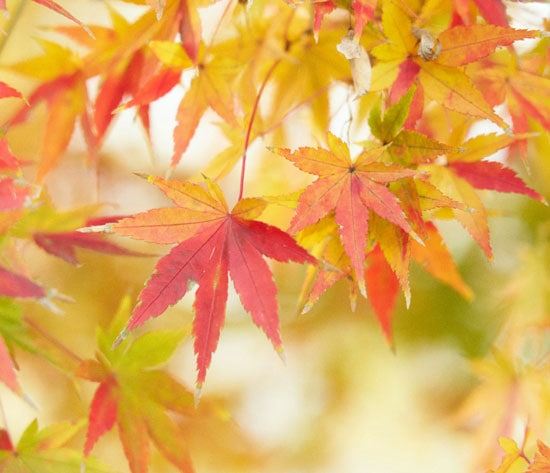
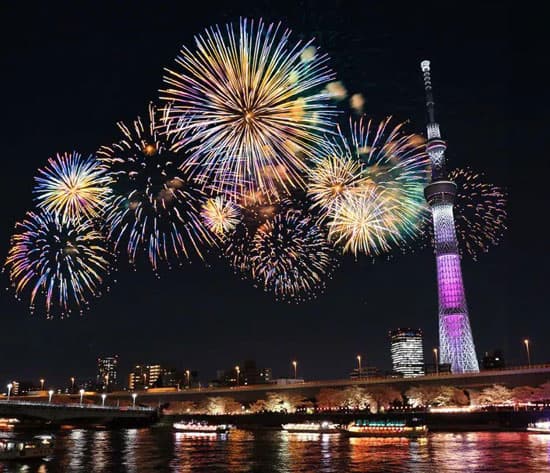
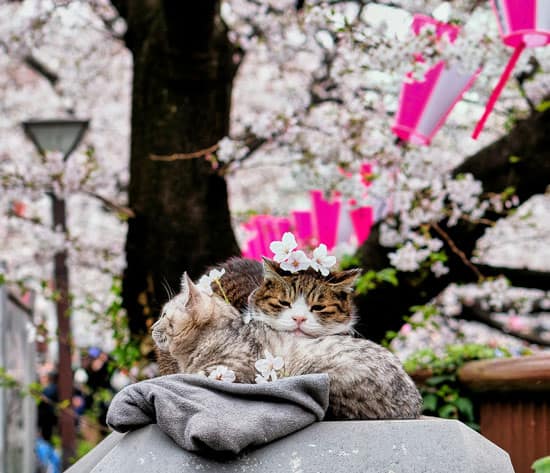
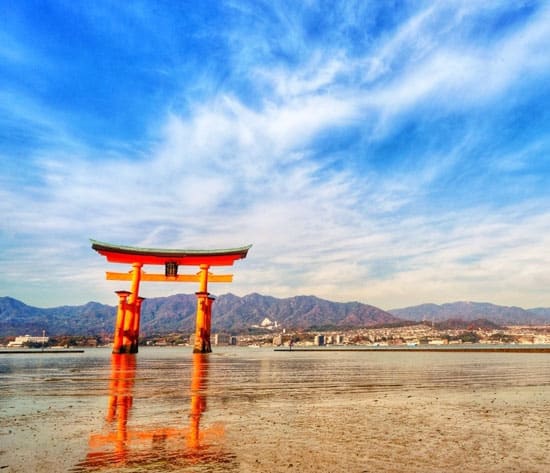
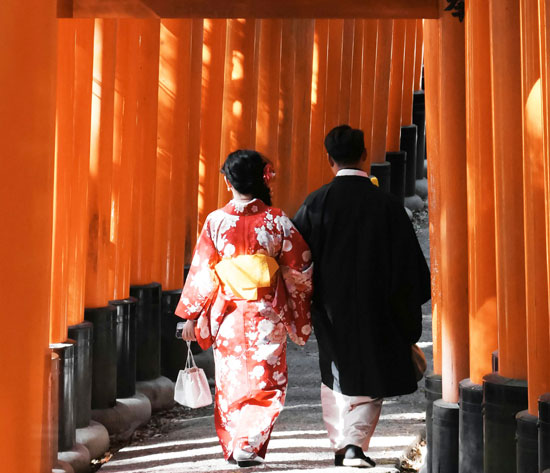
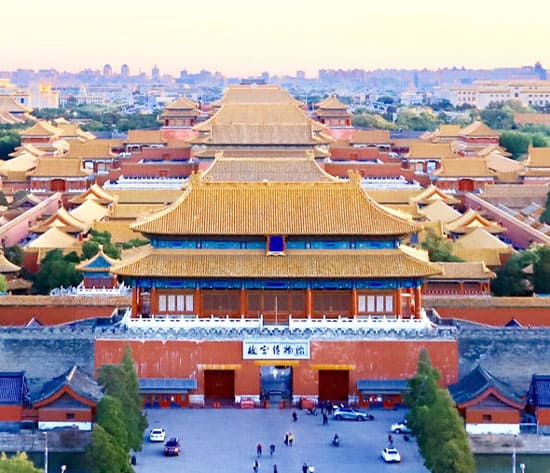
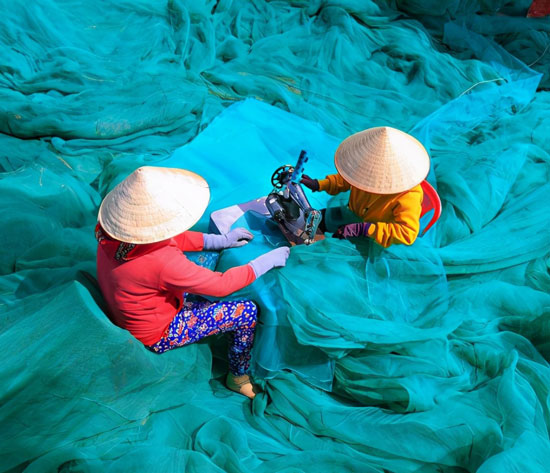
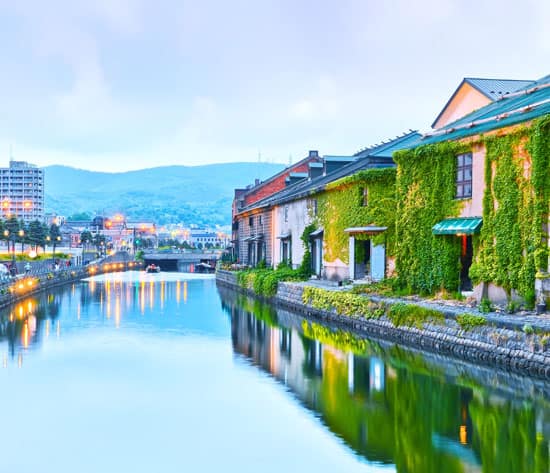
Have a Question?
You might see your comment appear on this page, but your email address and full name will not be published. Your personal information will remain confidential. Our Asia travel experts will get back to you as soon as possible. Required fields are marked *